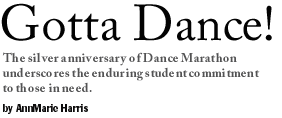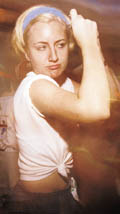

|
 |
|

(Photos by Andrew Campbell) |
Most college students suffer from sleep deprivation, of course, but at Northwestern's Dance Marathon -- even after 25 years -- the dancers still take the cake. Hoofers in last spring's silver anniversary event lightened the load on their feet with the knowledge that Dance Marathon remains one of the nation's largest student-run philanthropies. Since 1975, students have been dancing till dawn at the 30-hour event and into the night again, raising almost $4 million for 21 different charities. This year's theme, "What a Feeling," captured the sentiment so many students and alumni have for the marathon. "Northwestern students like a good challenge, and it's for a good cause," says Dustin Cook, a junior majoring in engineering, one of the two emcees who hosted the March marathon. "It's the one big event where everybody works together, and that probably helps it survive." As emcees, Cook and his friend Tom Nealis, a senior engineering student, helped keep the dancers going during the weekend, which raised a record $450,833, this time for the Chicago-based Children's Heart Foundation. For the second year, a portion of the proceeds also went to the Evanston Community Foundation, which assists local charities. Last spring's Dance Marathon began when Cook literally flew into the Louis Room in the Norris University Center with the Mission: Impossible theme song blaring in the background. Dangling from a pulley system donated by a special effects company, Cook landed in the middle of the crowd of dancers a la Tom Cruise in the Hollywood film. He and Nealis then pumped the crowd up with a choreographed dance and counted down the seconds until the marathon began promptly at 7 p.m. The largest single event on campus, Dance Marathon relies on the fundraising and organizing efforts of more than 1,000 students. This year, the almost 250 couples spent most of the fall and winter raising the $700 required of each pair to participate in the event. In addition to the dancers, more than 300 students who served on the 11 committees that run the marathon contributed $125 each. The rest of the money is raised through fund-raising events that take place in the fall and winter quarters. After the marathon begins, referees and the emcees encourage the dancers to stay on their feet and keep moving to the music. Throughout the event, the participants are given breaks to eat and, of course, opportunities to use the restrooms. During the night, they are allowed one 90-second shower. But for most of the 30 hours, there's no parking on the dance floor! The marathon is divided into 10 blocks of time, each with a different theme. After each segment, dancers have 10 minutes to change costumes to match the theme. Many choose also to lie down with their aching feet up against the wall until the next block begins. This year's themes included "Battle of the Sexes," "Sweatin' to the Oldies" and the final theme, "The Big Two-Five/It's a Great Time to Be Silver." The 25th anniversary was noted by the sealing of a time capsule, to be opened on Dance Marathon's 50th anniversary in 2024, and an alumni lock-in. For the lock-in, eight alumni who had served on past Dance Marathon executive boards were "arrested" and confined to a room in Norris. They were then given cellular phones to call friends and family for $10 donations toward their $100 "bail." The main reason Dance Marathon is still going strong is because it unites the campus, says Heather Lylis (S99), one of the special event's co-chairs. The first Dance Marathon was held in 1975 as a fraternity fund-raiser. Sponsored by Alpha Tau Omega and the Associated Student Government, the "Dance to Give Them a Chance" marathon benefited the American Epilepsy Foundation and the National Association for Retarded Citizens. Of the 21 couples dancing, only 15 made it to the end of the 52-hour marathon. The inaugural marathon raised more than $9,100. A quarter-century later, Northwestern students are still hustling to get the job done. "It was really amazing to feel the energy of everyone there," says Emeline Cokelet, a junior in journalism and first-time dancer. At times, her motivation came from friends on the dance floor, especially when she fell asleep standing up somewhere during the 29th hour. "I slowed down for a second and the next thing I knew my eyes were closed and my friend was shaking me and saying, 'You have to wake up! You have to keep going!'" Cokelet says. Keeping everything going -- from the actual dancing to the planning and organization of the event -- is a huge task. But for a generation, Northwestern students have met the challenge, and it looks like there's no stopping them in the future. AnnMarie Harris (J00) is a senior in the Medill School of Journalism.
|